
(a)
Interpretation:
Bond angle has to be predicted using VSEPR model for the given structure and also the hybrid orbitals on the central atoms has to be given. The molecule is polar or not also has to be indicated.
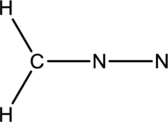
Concept Introduction:
Lewis structure is used for predicting the shape of molecules. From the steric number obtained in a Lewis structure, the molecular geometry can be predicted. VSEPR model can predict the shape of molecules considering their Lewis structure. Certain rules has to be followed in for the VSEPR model.
- The molecule will have a shape where there is minimal electrostatic repulsion between the valence‑shell electron pairs.
- The forces of repulsion between two lone pairs of electrons will be higher than the repulsion between lone pair and bond pair of electrons. This in turn will be higher than the bond pair‑bond pair of electrons.
The hybridized orbitals and the steric number can be related as shown below;
| Steric number | Hybridized orbital |
| 2 | |
| 3 | |
| 4 | |
| 5 | |
| 6 |
(a)
Explanation of Solution
Resonance structure:
The given species is shown below;
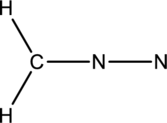
The total number of valence electrons is calculated as shown below;
A total of

Hybrid orbitals of central atoms in structure I:
The resonance structure is shown below;
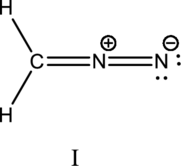
Hybrid orbitals of central nitrogen atom:
The nitrogen atom has does not have a lone pair of electrons and it is bonded to two atoms. Therefore, the steric number is calculated as shown below;
As the steric number is two, the hybridization of nitrogen atom is
Hybrid orbital of carbon atom:
The carbon atom does not have lone pair of electrons and it is bonded to three atoms. Therefore, the steric number is calculated as shown below;
As the steric number is three, the hybridization of carbon atom is
Hybrid orbitals of central atoms in structure II:
The resonance structure is shown below;
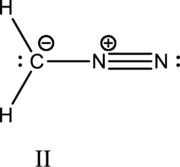
Hybrid orbitals of central nitrogen atom:
The nitrogen atom has does not have a lone pair of electrons and it is bonded to two atoms. Therefore, the steric number is calculated as shown below;
As the steric number is two, the hybridization of nitrogen atom is
Hybrid orbital of carbon atom:
The carbon atom have one lone pair of electrons and it is bonded to three atoms. Therefore, the steric number is calculated as shown below;
As the steric number is four, the hybridization of carbon atom is
Two resonance structures do not use the same hybrid orbitals because the hybridization of the carbon atom is different in both.
Polarity of the species:

From the above figure, it is found that there is a permanent dipole moment. Hence, the molecule will be polar.
(b)
Interpretation:
Bond angle has to be predicted using VSEPR model for the given structure and also the hybrid orbitals on the central atoms has to be given. The molecule is polar or not also has to be indicated.
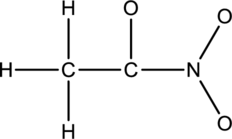
Concept Introduction:
Refer part (a).
(b)
Explanation of Solution
Resonance structure:
The given species is shown below;
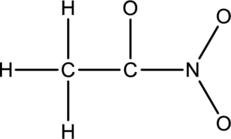
The total number of valence electrons is calculated as shown below;
A total of

Hybrid orbitals of central atoms in structure I and II:
The resonance structures is shown below;

Hybrid orbitals of nitrogen atom:
The nitrogen atom has does not have a lone pair of electrons and it is bonded to three atoms. Therefore, the steric number is calculated as shown below;
As the steric number is three, the hybridization of nitrogen atom is
Hybrid orbital of first carbon atom:
The first carbon atom does not have lone pair of electrons and it is bonded to four atoms. Therefore, the steric number is calculated as shown below;
As the steric number is four, the hybridization of carbon atom is
Hybrid orbital of second carbon atom:
The second carbon atom does not have lone pair of electrons and it is bonded to three atoms. Therefore, the steric number is calculated as shown below;
As the steric number is three, the hybridization of carbon atom is
Two resonance structures use the same hybrid orbitals because the hybridization of the carbon atoms and nitrogen atom are same.
Polarity of the species:

From the above figure, it is found that there is a permanent dipole moment. Hence, the molecule will be polar.
Want to see more full solutions like this?
Chapter 10 Solutions
Chemistry Principles And Practice
- I need the nomenclature of this compoundarrow_forward2. Name the following hydrocarbons. (9 marks) a) HHHHHHHH H-C-C- H-O-S b) HCEC-CH3 H H H H H d) c) H C=C- H H H e) CH3 CH3 CH2CH=CH-CH=CHCH3 HHHH H-C-C-C-C-H H HH H f) large CH2CH3 pola H3C section lovels tower, able ocart firs g) Tower H3C-CH2 then in H3C-CH-CH-CH3 enblbano bne noitsidab Copyright © 2008. Durham Continuing Education CH3arrow_forwardName the molecules & Identify any chiral center CH3CH2CH2CHCH₂CH₂CH₂CH₂ OH CH₂CHCH2CH3 Br CH3 CH3CHCH2CHCH2CH3 CH3arrow_forward
 Chemistry: Principles and PracticeChemistryISBN:9780534420123Author:Daniel L. Reger, Scott R. Goode, David W. Ball, Edward MercerPublisher:Cengage LearningChemistry: Matter and ChangeChemistryISBN:9780078746376Author:Dinah Zike, Laurel Dingrando, Nicholas Hainen, Cheryl WistromPublisher:Glencoe/McGraw-Hill School Pub Co
Chemistry: Principles and PracticeChemistryISBN:9780534420123Author:Daniel L. Reger, Scott R. Goode, David W. Ball, Edward MercerPublisher:Cengage LearningChemistry: Matter and ChangeChemistryISBN:9780078746376Author:Dinah Zike, Laurel Dingrando, Nicholas Hainen, Cheryl WistromPublisher:Glencoe/McGraw-Hill School Pub Co Chemistry: The Molecular ScienceChemistryISBN:9781285199047Author:John W. Moore, Conrad L. StanitskiPublisher:Cengage Learning
Chemistry: The Molecular ScienceChemistryISBN:9781285199047Author:John W. Moore, Conrad L. StanitskiPublisher:Cengage Learning Chemistry & Chemical ReactivityChemistryISBN:9781337399074Author:John C. Kotz, Paul M. Treichel, John Townsend, David TreichelPublisher:Cengage Learning
Chemistry & Chemical ReactivityChemistryISBN:9781337399074Author:John C. Kotz, Paul M. Treichel, John Townsend, David TreichelPublisher:Cengage Learning Chemistry & Chemical ReactivityChemistryISBN:9781133949640Author:John C. Kotz, Paul M. Treichel, John Townsend, David TreichelPublisher:Cengage Learning
Chemistry & Chemical ReactivityChemistryISBN:9781133949640Author:John C. Kotz, Paul M. Treichel, John Townsend, David TreichelPublisher:Cengage Learning Introductory Chemistry: An Active Learning Approa...ChemistryISBN:9781305079250Author:Mark S. Cracolice, Ed PetersPublisher:Cengage Learning
Introductory Chemistry: An Active Learning Approa...ChemistryISBN:9781305079250Author:Mark S. Cracolice, Ed PetersPublisher:Cengage Learning





